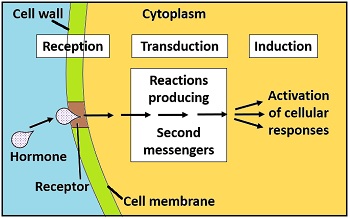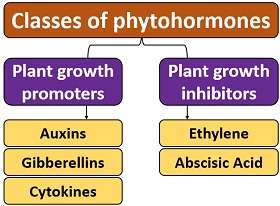Plant Growth Regulators are the chemicals derived naturally by the plants, which function is to regulate the length and thickness of plants. PGRs are molecules that can influence or inhibit plant growth.
It is also called “Phytophormones” that are generally active at very low concentrations. The PGRs are sometimes referred to as a natural regulator, as these are produced by the plant itself, and sometimes refers to as a synthetic regulator that is found naturally in the plants.
Content: Plant Growth Regulators
Meaning of Plant Growth Regulator
Plant Growth Regulators can define as the organic molecules that perform a pivotal role in different plant growth processes like tropism, elongation, and apical dominance. As PGRs are produced by the plants, these are also termed phytohormones or plant hormones that regulate the physiological activity of plants by either stimulating or terminating the plant maturation.

Therefore, phytohormones simply control the growth behaviour of plants. The phytohormones vary in their chemical structures but have similar physiological effects. Abscisic acid, auxin, cytokinins, ethylene and gibberellins are the five major classes of PGRs.
Classification of Phytohormones
Plant growth regulators have varied chemical compositions (ethylene, terpenes, and carotenoid derivates etc.). Based on the action of phytohormones on the growth behaviour of plants, there are two classes of PGRs:
Plant Growth Promoters
They promote cell multiplication, reproduction, flowering and germination processes. Examples are auxins, gibberellins and cytokinins.
Auxin
It was discovered first among the other PGRs, which are synthesized by the plant and have similar physiological effects to Indole-3-acetic acid (IAA). It first came into use by Charles Darwin while he was performing experiments on canary grass coleoptiles. After his experiment, he concluded that auxin promotes shoot elongation and tropic growth towards light.
It produces from the apical region of stems and roots. These plant hormones possess both natural and synthetic sources. Indole-3-acetic acid and indole butyric acid are the natural precursors, whereas naphthalene acetic acid and 2, 4-dichlorophenoxyacetic acid is the synthetic precursors.
Functions
- Stimulates cell expansion and elongation.
- Promotes development of adventitious roots on stem cuttings.
- It also promotes the development of lateral root development in tissue culture.
- Facilitates phloem and xylem differentiation.
- Regulates abscission of young fruits.
- Sometimes used in combination with cytokinins that promote cell division in tissue culture.
- Mediates phototropism.
- Used as herbicides to keep lawns free from weeds.
Gibberellins
It is produced by the young tissues of the shoots, in the developing seeds, rarely by roots and sometimes by the leaves. There are nearly 100 gibberellins known so far. It shows acidic behaviour and is denoted as GA1, GA2, GA3 etc. GA3 (Gibberellic acid), among which GA3 was the first to be discovered.
Functions
- Stimulate stem elongation.
- It breaks seed dormancy so that it can germinate into a plant towards the presence of light.
- Produces alpha-amylase in germinating cereals.
- Stimulates flowering in response to long days.
- Delays leaf and fruits senescence.
- Induces maleness in dioecious flowers.
- It helps in the growth of parthenocarpic fruits that are without seeds.
Cytokinins
It is also called a cytokine. These compounds are more or less similar to the adenine (aminopurine) that stimulates cell division.
Functions
- Stimulates cell division.
- Activates sink effect.
- Reduce senescence at the minimum concentration.
- Induce apoptosis at a high concentration.
- Stimulates morphogenesis in tissue culture.
- Stimulates the growth of lateral buds and leaf expansion by cell division & enlargement.
- Helps in chlorophyll synthesis.
- Converts etioplasts into chloroplasts.
- Enhance stomatal opening in some plants.
Plant Growth Inhibitors
These chemicals inhibit plants’ growth and development. PGIs promote dormancy and abscission in plants. An example is an abscisic acid.
Ethylene
Ethylene is a gaseous compound having the simplest chemical structure. It has effects like abscisic acid.
Functions
- Induce shoot and root growth and differentiation.
- Stimulates the phase of dormancy.
- Promotes abscission of leaves and fruits.
- Induce femaleness in dioecious flowers.
- Stimulates leaf and flower senescence.
- Helps in flower opening.
- Promotes fruit ripening.
Abscisic Acid
Abscisic acid functions as a stress hormone against abiotic stresses like drought, high salt concentration etc.
Functions
- Stimulates the closure of stomata.
- Makes plants resistant to water deficiency.
- Induces seed and bud dormancy.
- Induces synthesis of storage proteins.
- Inhibits shoot growth.
- Inhibits the activity of alpha-amylase stimulated by gibberellins.
Applications of Phytohormones
- Germination: It is the process when a seedling begins to grow from the embryo of the dormant seed. Dormancy is the resting phase where all the metabolic activities are suspended, and the application of auxins and gibberellins can break down this dormancy phase into the metabolic phase.
- Rooting: Auxins are the root promoting organic compound used as rooting hormones that are widely used on stem cuttings.
- Callus Induction: Cytokinins and auxins induce callus formation from the explants in tissue culturing.
- Growth Inhibitor: It inhibits apical growth and promotes lateral bud growth, which results in bushy plants with an increased number of flowers and fruits.
- Thinner: Thinning is the process that maintains the tree structure by reducing the density of flowers/fruits.
- Chemical Pruning: It also refers to pinching or suckering that restricts the growth of the plant longitudinally but thickens the plant by the growth of lateral branches. Growth inhibitors are used for chemical pruning.
- Defoliant: It serves as the mixture of substances that causes the dropping of the leaf foliage from a plant, with or without causing abscission. These are applied to cotton and facilitate mechanical harvesting.
- Desiccant: It artificially promotes the drying of plant tissues. Desiccation is a hastened drying process that results in the removal of leaves, as desiccant eliminates water from the green foliage.
- Fruit Ripener: These are the substances that can hasten the ripening process and artificially ripen fruits for commercial purposes.
Conclusion
Therefore, we can conclude that the plants also require a few chemical substances that can regulate their growth and physiological functions along with oxygen, water, sunlight etc. The plant growth regulators are simple organic molecules that possess different chemical compositions and molecular structures. They are well known for their regulatory functions, where they can stimulate, retard or inhibit the growth rate in plants.
